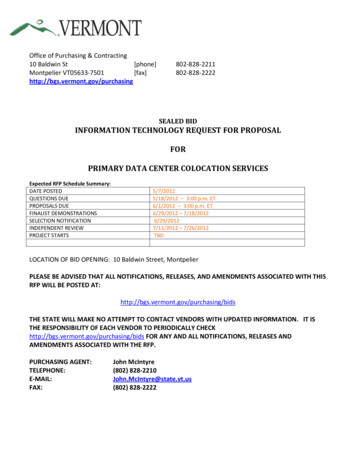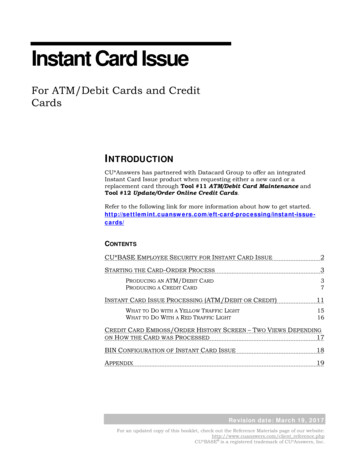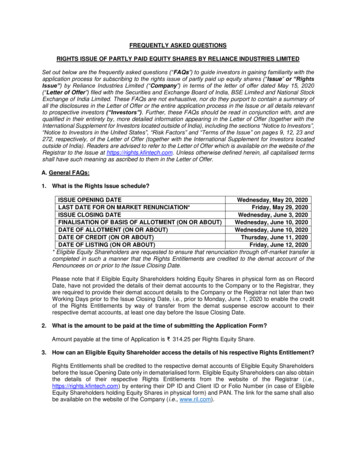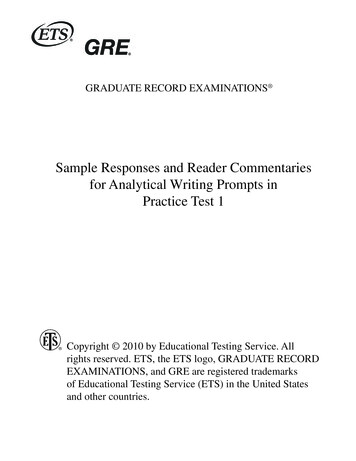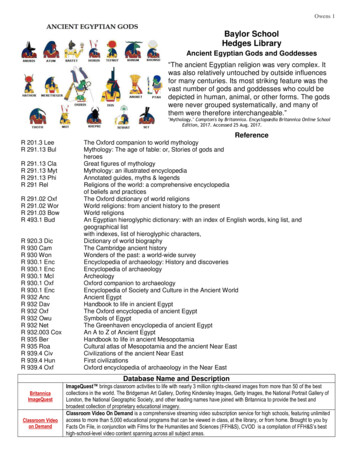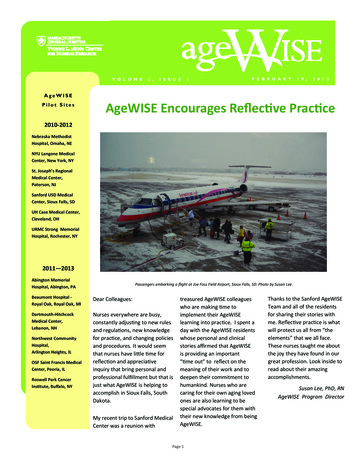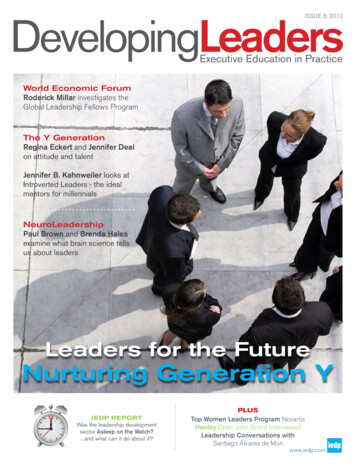
Transcription
DevelopingLeadersIssue 6: 2012Executive Education in PracticeWorld Economic ForumRoderick Millar investigates theGlobal Leadership Fellows ProgramThe Y GenerationRegina Eckert and Jennifer Dealon attitude and talentJennifer B. Kahnweiler looks atIntroverted Leaders - the idealmentors for millennialsNeuroLeadershipPaul Brown and Brenda Halesexamine what brain science tellsus about leadersLeaders for the FutureNurturing Generation YPLUSIEDP REPORTWas the leadership developmentsector Asleep on the Watch?.and what can it do about it?Top Women Leaders Program NovartisHenley Dean John Board InterviewedLeadership Conversations withSantiago Álvares de Monwww.iedp.com
Leadership DevelopmentGlobal Leaders for TomorrowWorld Economic Forum: Global Leadership Fellows Program“More leaders have been made by accident, circumstance, sheer grit or will, thanhave been made by all the leadership courses put together. Leadership courses canonly teach skills. They can’t teach character or vision, and indeed they don’t even try.Developing character and vision is the way leaders invent themselves.”Warren Bennis ‘On Becoming a Leader’All projects are restricted by resource limitations that restrain their design and operation.For many leadership development programs the main limitation may be financial.However, when large organizations introduce such programs for their top executives and‘high-potentials,’ budget restrictions are often not the main barrier. Time is. Freeing upparticipants long enough for meaningful learning experiences, and arranging a schedulethat works with the calendar of potential attendees, key faculty, and other top leaders,is often a challenge – as is ensuring that the quality and commitment of participants isuniformly high.With these program limitations in mind, it is exciting to discover a program where theserestrictions do not apply; where program time, access to world-renowned thought-leadersand participant quality are all at a level that most leadership development directors canonly dream of.The World Economic Forum (Forum) is best known for its all-star, glittering one-weeksummit held in January each year in Davos, Switzerland, where world leaders from politics,commerce and NGO’s rub shoulders with each other, network and exchange ideas –principally for improving global society, be that financial systems, economic growth, healthfor all, environmental systems or social development. These are five of the key themesthe Forum focuses on during the Davos week – and for the other 51 weeks of the yearwhen their high calibre staff remain focused on the Forum mission statement of being“committed to improving the state of the world”, by monitoring long-term risks, buildingnetworks, relationships, long-term scenarios and solutions with influential organizationsaround the globe.The Forum is a well-funded organization, supported by its 1000 corporate members,predominantly businesses with a turnover of over 5 billion. This allows it some unusuallyattractive benefits for a non-profit organization: primarily it is its access to the topmanagement of their corporate members, people who have great insight and influence;this network also attracts senior politicians from around the globe and leaders from othersectors who need to work with these corporations to get projects implemented. Thiscombination of access to global influencers in both the corporate and political spheresallied to project work that has a beneficial social impact on major global themes enablesthe Forum to attract young executives of a very high calibre to join them as managerson three-year contracts. The Forum gets over 2500 applicants for around 20 placesavailable each year so they have the luxury of being able to select candidates that fit theirrequirements very closely.42 Developing Leaders Issue 6: 2012By Roderick Millar
Leadership DevelopmentA programwhere time,access toworld-renownedthought-leadersand participantquality are allat a level mostleadershipdevelopmentdirectors canonly dream ofThe work at the Forum that is made available to these high-potential leaders comeswith an additional and unique bonus – their day jobs are fully integrated with a very-highlevel leadership program, the Global Leadership Fellows Program (GLFP). The GLFPis unusual in many aspects. It is three-years in duration, considerably longer than otherexecutive development programs and longer too than any MBA program the fellows mayhave already completed. It is fully integrated into their work roles, so the knowledge andskills they gather during the academic modules is woven into their work, and their workexperiences in turn feed into the learning process. Moreover, with the stream of worldleaders passing through the Forum’s doors in Switzerland, the opportunity to interact andlearn from them is unparalleled. What is more, as Juraj Ondrejkovic, Associate Directorfor the GLFP, says “the program is very broad in its remit. It creates leaders for a wholerange of sectors, public, private and NGOs and across lots of different industries andspecialisations. We are not just developing leaders for the Forum but leaders who canmake a difference now and in the future outside the Forum.”Developing Leaders Issue 6: 2012 43
Leadership DevelopmentOndrejkovic highlights the fact that at the end of the three year contract only abouthalf of the fellows stay-on at the Forum. The others go on to use their newly-acquiredskills in senior roles in other influential organizations. Recent alumni have becomeStrategy Directors at Sanofi-Aventis and Anglo-American for example, while others goto policy roles in government. Ondrejkovic says the program’s broad scope allows it todevelop leaders that can adapt and innovate in these roles. He also points out that whilein most organizations the departure of high-potential and expensively developed talentafter a leadership program ends would be seen in negative terms, the Forum considersit an investment. Its reach, influence and impact increase by having alumni in otherorganizations.” Many people fail to see the opportunity in building their alumni network– but look at McKinsey which in many respects has founded its consulting influence onhaving ex-McKinsey consultants in leading positions around the globe. It is the same here– the fellows go on to important roles that benefit society and keep their links back to theForum. Everyone wins. “This is part of the reason that makes the GLFP so different. Thecontent of the program is both tied with participants’ everyday work and designed like anopen program at a business school, with no single final agenda but a broader purpose thatits benefits be applied for improving the state of the world.Stephen Langton, Director of Deloitte’s Centre for Strategic Leadership and an associatefaculty of the program has described the program as “unique, an outstanding program, forme the best I have seen.” So with the luxury of time, access, high calibre participants anda broad impact agenda, things not available to most organizations, what does the ForumGLF program look like?The program started in 2005 and was, as the program’s Dean, Gilbert Probst explains,a return to the Forum’s training roots. When Klaus Schwab founded what was then theEuropean Management Forum in 1971 it was to enable European businesses to catch upwith US management practices. The GLFP was founded on a broadening of this principleand Schwab and Probst, who respectively were and are still business professors at theUniversity of Geneva, were keen to draw on the best available thinking and practiceglobally that they could find. Probst stresses that “the last thing we wanted to do wascreate another MBA program – the GLFP is a finishing school for leaders after they havecompleted their studies.”44 Developing Leaders Issue 6: 2012
Leadership DevelopmentGilbert Probst has developed the program with a close eye on developmental psychologistRobert Kegan’s ‘Adult Development /Stages of Maturity Theory’ (see diagram) where anincreasing level of self-awareness and systemic awareness is achieved at each additionalstage. The fifth level is only reached by a small minority of people, but enables those thatdo to observe, encourage and enable their teams to reach successful outcomes not onlyfor themselves and their organizations, but also for the broader systems in which theyare embedded. The Forum is conducting a study of the fellows to see how the programfacilitates progress through these stages, and whether it is possible to accelerate it.Participants are closely monitored as they progress through the GLFP. Alongside theassessment of their stage of development in Kegan’s levels of mental complexity,participants take a variety of tests at the outset of the program, including the MayerSalovey-Caruso Emotional Intelligence Test (MSCEIT) that scores individuals on fouremotional aptitudes: perceiving, facilitating, understanding and managing emotions.As they continue through the program their systems thinking abilities are monitoredthrough the HBDI (Herrman Brain Dominance Instrument) assessment while at Wharton,and INSEAD conducts its GELI (Global Executive Leadership Inventory) assessmentdeveloped by Manfred Kets de Vries to evaluate twelve primary leadership abilities. Morestandard assessments include the MBTI, 360 feedback and annual performance reviews.These complement a wealth of feedback from their managers as well as external andpeer coaches.At the end of the third year Egon Zehnder International, the global executive searchand leadership specialist, conducts their proprietary executive assessment of eachfellow to appraise their individual strengths and competencies which are drawn upon incollaboration with the fellow to decide where they would best flourish after the programends. These assessments amount to an enormous amount of data collected on eachindividual over the three-year program that the Forum is using to underpin some researchon the ability of leadership programs to accelerate developmental learning.But while there is a distinctconceptual foundation to theprogram, and the Forum supportsrigorous research to assess itsimpact and advance knowledgein leadership development theoryand practice, the GLFP is farfrom a scientific experiment. Asthe Warren Bennis quote at thehead of this piece indicates, realleadership growth is a factorof character and vision and thisultimately can only be developedthrough experience, which isitself factored by time. The three-year program is carefully balanced around the 70:20:10learning ratio, with the bulk of the learning being experiential, and only 10% beingacademic interventions, albeit in some of the world’s best classrooms. The GLFP not onlyoffers an incomparable series of leadership experiences, it also facilitates their translationinto long lasting learning through coaching, mentoring and reflective opportunities.When discussing the most impactful elements of the program with past participants, theexperiential events inevitably came to the fore. Each winter in the second year of theprogram, the cohort embarks on a five day expedition to a mountain hut in the GemmiPass, 2314m (7,600 ft) up in the Swiss Alps. Far from their everyday environments andimmersed in a dramatic winter landscape, the fellows undertake – and reflect upon– a series of group activities of increasing complexity in a demanding and potentiallyhostile environment. Unlike most outdoor leadership programs, however, the purpose ofthe expedition is not to provide a startling backdrop for a retreat or to push participantsto their physical and emotional boundaries. Its aim is providing a space for collectiveDeveloping Leaders Issue 6: 2012 45
Leadership Developmentreflection, learning and experimentation. The mountain environment is a vivid reminderof the beauty and fragility of natural resources leaders’ decisions often impinge upon.But the real challenges occur within and between participants. Ramya Krishnaswamy,who joined the GLF in 2009 and is currently an Associate Director for EnvironmentalInitiatives recalls the Alpine expedition as ‘well out of my comfort zone; but the change ofenvironment provided a good space to reflect on, explore and share critical points of lifeand core personal values with a small group of fellows and a coach’.“We bring to thesurface whatleadership meansto them as acommunity those meaningsinevitably shapewho they become,how they relate,and how they lead”The group of fellows were accompanied in this expedition by Gianpiero Petriglieri, anassociate professor of Organizational Behaviour at INSEAD. Petriglieri, whose researchexamines the interface between leaders’ activities and their identity, specializes inexperiential leadership development. Together with colleagues Heather Cairns-Leeand Declan Fitzsimons, he designed a workshop that aimed to deepen participants’understanding of the overt and covert aspects of leadership, and to develop their capacityto exercise it effectively and responsibly. The three did not take up traditional faculty roles,but rather served as leadership consultants throughout the workshop. There were nolectures or slides. Events that unfolded during the mountain activities provided the primarylearning material. Participant groups reflected upon them on an on-going basis with theconsultants’ assistance. At the end of the workshop, each consultant took the role ofpersonal coach for their group’s members, helping individuals explore the links betweentheir experiences in the mountains and those back home, articulate their learning, andrefine a plan for on-going development.The Gemmi workshop is designed to provide what Petriglieri calls an ‘identity workspace,’that is, a learning environment conducive to the development of both individual leadersand leadership communities. As he put it, “most leadership programs focus exclusively onthe individual leader and his or her behaviour. They are veiled attempts to help participantsget their way. The vector of influence, in these programs, moves from the leader out. Thisview of leadership is as appealing as it is simplistic and dangerous. Leaders are shapersas much as they are stewards. The communities in which leaders operate are not just‘context.’ They can make or break leaders. History and every day experience show thatleaders can be empowered by their followers as much as they can be driven insane. Forthis reason we put equal focus on influence and representation, on how leaders influencegroups and how groups, in turn, influence leaders – consciously and unconsciously. We46 Developing Leaders Issue 6: 2012
Leadership DevelopmentIDENTITY WORKSPACES FOR LEADERSHIP DEVELOPMENTOver the last decade, researchers and practitioners have called for rethinking howleadership is developed and practiced. Traditional leadership programs, focused onthe acquisition of conceptual knowledge and requisite skills, are limited in preparingleaders to face the turmoil, uncertainty and systemic challenges of the 21st century.On the basis of a decade of research and practice with colleagues Jennifer Petriglieriand Jack Wood, INSEAD associate professor Gianpiero Petriglieri argues thatconceptualizing leadership programs as ’identity workspaces‘ helps to meet the demandfor leadership in ways that benefit individuals, organizations, and society.Like the World Economic Forum, a number of global corporations have embraced theirview and approach. Balancing theory and practice, experience and reflection, intellectand emotion, programs designed as identity workspaces combine the pursuit ofpredetermined learning objectives with the provision of a space where participants canset the learning agenda, individually and collectively. They personalize and contextualizeparticipants’ learning, inviting them to wrestle with the questions “What does leadingmean to us?” and “Who am I as a leader?” Focusing on what leaders do, who theyare, and on whose behalf they lead, identity workspaces deepen and accelerate thedevelopment of individual leaders, strengthen leadership communities mindful of (notsubservient to) their organization’s culture and aims, and foster responsible citizenshipin society at large.endeavour to explore how personal history and aspirations, as well as group and socialpressures, influence the way participants think, feel and act in leader and follower roles.We also bring to the surface what leadership means to them as a community. This iscrucial, as those meanings inevitably shape who they become, how they relate, and howthey lead.”The outdoor activities were supported by Julie-Ann Clyma and Roger Payne, twointernationally respected mountaineers who are also well-positioned to give insights intoleading in harsh environments having worked with mountain development organizationssuch as the Aga Khan Rural Support Programme (AKRSP), the World Conservation Union(IUCN) and the United Nations Environment Programme (UNEP).It is well understood that the process of surfacing and questioning deeply held assumptions,and transferring new ideas and concepts so that they become new habits is best donethrough practice combined with reflection. Learning on the job alone, however, only goesso far in fostering such learning. The pressure of getting work done can leave little timefor reflection, limit experimentation, and limit the learning of even the most dedicatedhigh-potentials. This is why leaders’ development can be greatly enhanced by skilfullyfacilitated experiential engagements in a secluded, intensive and novel environment –where participants have enough distance from the habits and culture of their workplace,and can focus on examining and experimenting with their behaviour. The Gemmi Passexperience weaves together the unusual environment, the reflective space, and thememorable activities – all facilitated by the very best of academic thought-leadership andprofessional coaches. “The field of leadership development is obsessed with methods andactivities, because methods can be patented, marketed and sold” Petriglieri added whenasked what made the Gemmi experience truly unique, “but methods alone don’t developleaders. People do. It’s the participants’ commitment to learning, and the sensitivity andskills of the professionals who facilitate that learning, that make a difference. Not themountain, the hut or the activities.”48 Developing Leaders Issue 6: 2012
Leadership DevelopmentThe purpose isto develop highlyeffective leaders,who have. greaterawareness ofthemselves,their effect onothers and on thechallenges facingthe world today andin the futureClearly not all the GLF program takes place in such unusual surroundings. Today thereare five schools involved with the program on a regular basis: Wharton, INSEAD, LondonBusiness School, the Columbia School of Arts and the Earth Institute at ColumbiaUniversity. Participants spend one week a year at each school during the first two yearsof the program. Gilbert Probst also draws on a network of leading faculty and deans whodeliver shorter sessions to the fellows through the program. “The faculty that we accesssuch as Subramanian Rangan (Professor of Strategy and Management and SocietalProgress at INSEAD), Herminia Ibarra (Professor of Leadership and Learning at INSEAD),Mike Useem (Professor of Management and Director, Center for Leadership and ChangeManagement at Wharton), Julian Birkinshaw (Professor of Strategy and Entrepreneurshipat LBS) and Carol Becker (Head of the Columbia School of Arts) have all challenged theprogram and shaped its development” observes Probst.The Wharton faculty invest much time discussing and re-shaping the program with Probstand Ondrejkovic at the Forum as it progresses from year to year. Harbir Singh leads theForum faculty input for the school, but Mike Useem and program director Diane Eynonalso input ideas to keep the content and design relevant to evolving global challenges.While at Wharton the first year cohorts focus, under the leadership of Prof Useem, is‘Personal Influence and Persuasion’ building on Useem’s idea of ‘leading up’, where it isas important for leaders to be able to influence their peers and superiors as much as theirfollowers. The second year cohort theme is ‘Leading Social Impact’, focusing on socialinnovation around issues such as ‘Catastrophic Risk Management’, ‘Urban Globalisation’and ‘Sustainability’. While much of the content for this is drawn from the thought-leadersat Wharton such as Harbir Singh and Peter Cappelli this year the fellows had an increasedexperiential engagement by meeting and exchanging experiences with the students atSummer Search, a national social enterprise program for low-income students givingthem the opportunities and support they need to transform their lives, achieve their ownpotential, and create change as role models and everyday leaders.Eynon describes the conversations that the two sides engaged in as a “very interactive andwonderful dialogue as they shared stories of their journeys and exchanged experiences.It was powerful to create an opportunity for the fellows to have exposure to the Whartonfaculty and also the Philadelphia community.” One group of fellows took time out after theprogram to go back to Summer Search to see if they could work with them further – asign of true engagement and connection with the group.Developing Leaders Issue 6: 2012 49
Leadership DevelopmentThe real strength of the program. carefully thought out design and mix ofcontent and experience. that makes the program so effective and allowsthem to follow the Forum maxim and ‘improve the state of the world’”Minds at Work” methodologyRobert Kegan’s Adult Development mingmindThe GLFP draws from the other schools it has long-term relationships with to deliverthe corss-disciplinary breadth it requires. Amongst these the workshops from the EarthInstitute faculty at Columbia University focus on the “Global Sustainability and Complexity”program which promotes innovative thinking about global issues. It takes a multifacetedapproach to these issues through curriculum on climate science and risk, global publichealth, resource management, and alternative energy solutions from on-going researchprojects, and feature visits to campus research labs and meetings with representativesfrom government agencies and private sector stakeholders.The purpose of the GLFP is to develop highly effective leaders, who have been exposedto a broad range of challenges and experiences so that they have built greater awarenessof themselves, their effect on others and how they can bring their skills to bear effectivelyon the challenges facing the world today and in the future. The GLF program has thescope in terms of duration and breadth to allow these high-potential managers tounderstand themselves and their impact better and use the thought-leading insight andtransformational experiences they have access to to adapt their behaviours to achievehigh-impact results. However, the real strength of the program is not so much the rawingredients, as enticing as they are individually, it is the carefully thought out designand mix of content and experience that Probst has developed that makes the programso effective and allows them to follow the Forum maxim and ‘improve the state of theworld’. As Nick Davis, Deputy Head of Strategic Risk Foresight at Forum, who completedthe program in 2009 notes “the great value of the program is a bit serendipitous, it istaking advantage of the CEO’s who come through the door, there are a lot of amazingopportunities but they are not necessarily all pre-planned. But supporting this serendipityis the academic foundation of the program. 70% of the learning is through osmosis and30% through structured academics that enable the opportunity to reflect and analyse.This is what Gilbert and Juraj do particularly well. It makes everyone very consciousof their own status of development. I am a lot more reflective now and that’s the GLFprogram that has done that.”50 Developing Leaders Issue 6: 2012
Despite much discussion about the need for leadershipdevelopment in corporate and public organizations, andthe considerable industry that surrounds it, this is the firstauthoritative periodical focused entirely on this area.Developing Leaders looks at the critical confluence betweenthe provision of executive education and the real everydayneeds of organizations to strengthen their managementteams, their corporate performance, and their leadership.The publication presents the latest thinking and most recentdevelopments in both academic and commercial executiveeducation provision worldwide, what it is achieving and whichare the best models for success, sharing the experience andexpertise of top leaders and world class educators.Developing Leaders is published in both hardcopy andonline “page turning” format. The quarterly magazinecomplements the IEDP website - the definitive resource forexecutive developers worldwide.www.iedp.com
level leadership program, the Global Leadership Fellows Program (GLFP). The GLFP is unusual in many aspects. It is three-years in duration, considerably longer than other executive development programs and longer too than any MBA program the fellows may have already completed. It is fully integrated into their work roles, so the knowledge and


